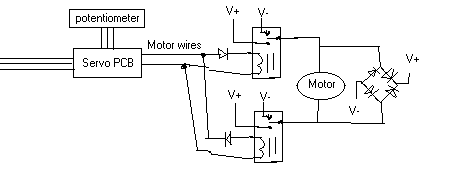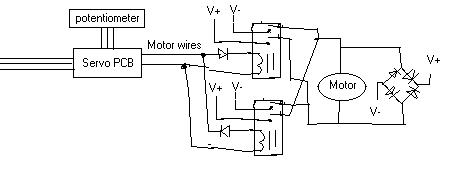
If you want to have both forward and reverse you need two relays.
Servo motors have three main part's. A Control PCB, A motor and a Potentiometer.
Tasks
Make it spin constantly.
Make it drive relays
To make a servo spin constantly you need to have the potentiometer positioned exactly in the center and not move.
To do this on the Futaba S3001 simply remove the connecting piece between
the main gear and the potentiometer.
On the hitec HS-300, however I had to cut the wires and add an external
pot.
Futaba S3001 with connecting clip
Futaba S3001 Electronics
Hitec HS-300 with external pot
To make it drive relays you need to cut the two motor wires and connect them to a diode and relay.
Note: If there is a third wire connected to the can of the motor just ignore it, however if the wire is connected to a terminal then you probably have a high priced coreless servo and you would be better to put it back together and buy a cheep servo.
Note: The diodes across the motor reduce relay arching and RF noise.
The PCB can only drive about 100 mA so keep the coil resistance above
50 ohms.
You can use a small relay to drive a larger relay if necessary.
Here is the schematic for having the Servo board turn on and off a motor.

If you want to have both forward and reverse you need two relays.
With Braking

Free wheeling
